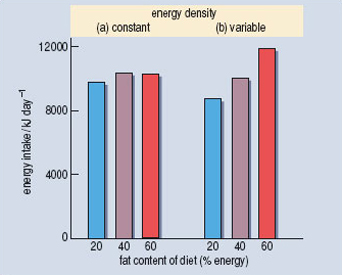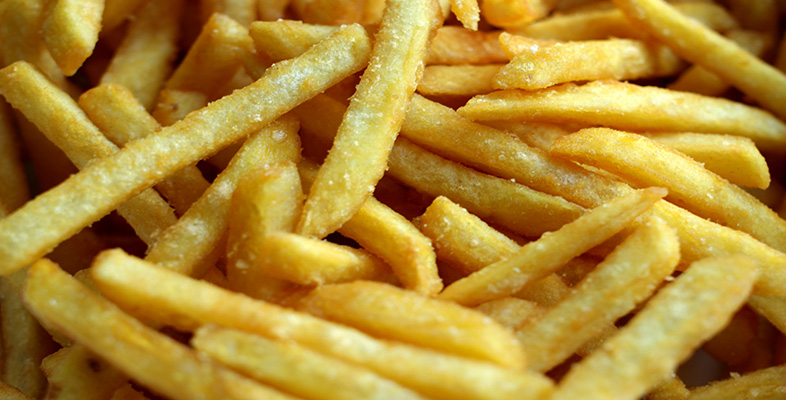2.2 Experimental studies of energy balance
The energy that a human takes in, primarily in food or nutritive fluids, has to be balanced by the energy lost in various ways. Some energy is used to maintain basic metabolic processes, some in physical activity while the remainder is lost as heat, or in the faeces or urine. If energy input and output do not balance, then the residue must either result in a loss or a gain in body weight.
One way of estimating these energy fluxes is to use the technique of whole room indirect calorimetry. Volunteers live on their own in a small suite of rooms which are sealed from the outside environment. The room can also contain exercise equipment. Food and water are provided through an airlock, and the exact amounts of carbon dioxide produced and oxygen used are measured. It is then possible to calculate an overall energy budget for each individual.
In one experiment of this type, participants were divided into three groups, each group receiving a diet of different fat content (Poppitt and Prentice, 1996). The other constituents of the diet, which were mainly protein and carbohydrate, were varied in such a way as to keep the overall energy density of the diets constant.
Activity 18
What is the energy density of a diet?
Answer
The number of calories (or joules) in a standard quantity (often 100 g) of that food.
The participants in this experiment were not aware that their diets were being manipulated in this way. In practical terms this kind of manipulation is achieved by, for example, substituting fat for carbohydrate within a yogurt while, at the same time, ensuring that the sensory characteristics (e.g. taste, smell and feel) do not change.
The results of this experiment are shown in Figure 6(a).
Activity 19
How did the voluntary energy intake of the participants vary as a function of the fat content of the diets when energy density is constant?
Answer
The overall result was straightforward: the energy intake of the volunteers hardly varies as a function of the amount of fat in the diet.

The apparent difference between the 20% and 40% groups was not significant. In addition there was no significant change in body weight over the experimental period of a few days.
In a second experiment the participants were again divided into three groups. Now each group received a diet in which the fat content had been covertly manipulated so as to vary the total energy density. One group received a diet which was relatively low fat and low energy, in a second group it was relatively normal whereas the third group received an energy-dense, high-fat diet. Other factors, such as the palatability of the foods provided, were again held constant. Surprisingly, the participants in the different experimental groups ate about the same number of grams of food each day regardless of its energy content.
Activity 20
Look at Figure 6(b). What was the consequence of this behaviour for the energy intake of the participants?
Answer
The consequence was that participants in the high energy density and fat content group had a higher energy intake than those in the groups provided with foods of lower energy density and fat content.
One result of these different energy intakes was that participants in the high-fat group increased in weight during the study period whereas those on the low-fat group lost weight. Taken together, the results of these experiments suggest that humans don't respond very accurately to changes in the energy density of their diet especially when their diet is very high in fat!
Detailed calculations based on these experiments suggest that excess consumption of about 3 × 104kJ of fat had generated about 100 g of adipose tissue by the end of the experimental period. Let’s relate this to what one major fast food retailer said at the time (2004) about their products; a hamburger and french fries was shown on their website as containing 2.92 × 104 kJ with a high proportion of that energy being in the form of fat. (Big Mac™ and regular fries were shown in 2004 as 699 kC (kcal) with an energy density of 494 kC per 100 g. 1 joule is approx 0.239 kC, giving a total energy content of 2924 kJ and an energy density of 2066 kJ per 100g (McDonalds, 2005).) There is a good deal of evidence to suggest that dietary fat, protein and carbohydrate may differ in the degree to which they can induce satiety – that rather pleasant feeling of satisfaction and fullness that we experience at the end of a meal. Carbohydrate and protein, when matched in terms of energy content, are very much more effective in enhancing satiety than is fat. You can now easily imagine how regular consumption of energy dense, high-fat foods might translate into increased body weight.
Another dietary factor that may be related to the increased incidence of obesity is the use of fructose derived from corn (high-fructose corn syrup) as a sweetener in soft drinks. Fructose is a simple sugar, like glucose, but differs from it in several important ways. Fructose can be absorbed by cells in the absence of insulin, and is also a poor signal for insulin release. Once in a cell it can be very easily metabolized into glycerol, one of the building blocks for fat (see Section 2.8.1 on Adipose tissue, which should be read after completing study of Section 2.6). Bray (2004) has pointed out the very close parallel between increases in the use of high-fructose corn syrup in the food industry and the incidence of obesity in North America. Of course, soft drinks sweetened in this way are frequently consumed together with the kinds of energy-dense, high-fat foods that we discussed in the last few paragraphs, so it will not be easy to disentangle the effects of these two factors. Looking at the data as a natural scientific experiment we might say that the effects of energy-dense, high-fat foods, and of soft drinks sweetened with corn syrup, on the incidence of obesity are confounded together.
Complementary (non question-based Activity)
Collect the wrappers of some typical snack foods. Look at the dietary information. How effective are they likely to be at inducing satiety? What contribution might they make to total daily energy intake? People often feel that a savoury snack (e.g. crisps) might be healthier than a sweet snack (e.g. chocolate). Does the dietary information that you have just collected support this idea?
